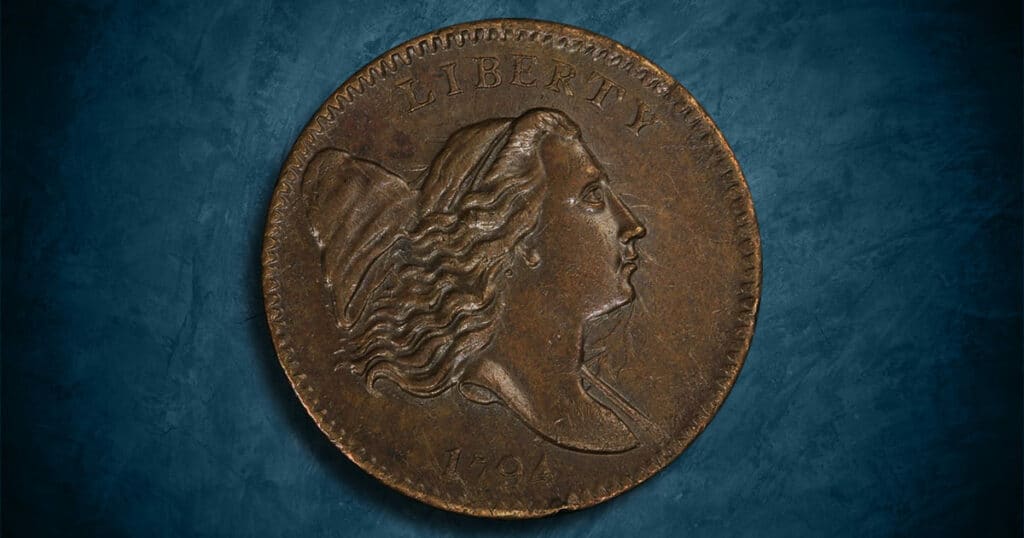
First authorized by the Coinage Act of 1792 on April 2, 1792, the coin was produced in the United States from 1793 to 1857. The half-cent piece was made of 100% copper and was valued at five milles, or one two-hundredth of a dollar. It was slightly smaller than a modern U.S. quarter with diameters 22 mm (1793), 23.5 mm (1794–1836) and 23 mm (1840–1857). Coinage was discontinued by the Coinage Act of February 21, 1857. They were all produced at the Philadelphia Mint.
There are several different types of half cents:
- Liberty Cap, Left (designed/engraved by Henry Voigt) – issued 1793
- Liberty Cap, Right (large head designed by Robert Scot, small head designed by Scot-John Gardner, engraved by Robert Scot) – issued 1794 to 1797
There are no mint marks on any of the coins (all minted at the Philadelphia Mint) and the edges are plain on most half cents. On the 1793, 1794 and some 1795 coins and a variety of the 1797 coin, it was lettered TWO HUNDRED FOR A DOLLAR and another 1797 variety had a gripped, or milled, edge.
Liberty Cap, Left
- 1793 – 35,334
Liberty Cap, Right
- 1794 – 81,601
- 1795 – 139,690
- 1796 – 1,390
- 1797 – 127,840
The US Mint was founded shortly after the founding of the country itself. One of the first coins
On the obverse side of the Liberty Cap Half Cent, you will notice the center of the face is marked by the leftward-facing bust of Lady Liberty. Lady Liberty is depicted in stunning detail, showing her bow-tied hair being blown in the wind. Arching overtop of the central image is an inscription which reads “Liberty.” Beneath the central image, the 1793 year of minting is inscribed. Around the outer edges of both sides of the coin, there are raised dots which give the coin some added texture.
The coin’s reverse can best be described as ornate, as the detail and imagery is second to none. In the very center, the coin’s “Half Cent” face value is marked. Partially surrounding this inscription is a wreath that is tied together with a bow. Beneath the bow you will see an inscription which reads “1/200,” or the coin’s face value. Finally, arching overtop of the reverse are the words “United States of America.”
The Libertas Americana medal that inspired the 1793 half cent was designed by French medalist Augustin Dupre as a celebration of American victories in the Revolutionary War. Intricately detailed and highly expressive, the medal made an excellent model for a coin. But the original adaptation of the design lasted only one year. In 1794 Chief Engraver Robert Scot modified the design by enlarging the bust of Liberty and having her face right rather than left. He also greatly increased the size of the “mob” cap set on top of the Liberty pole. An innovative mechanical experiment was tried with the reverse. Rather than using individual device punches to make up the die, Scot created a complete reverse hub that included the wreath, all lettering, and denticles around the border. The wreath was like the one from the previous year but without the sprays of berries. The entire design was sunk in higher relief than the half cents of subsequent years. The half cents of 1794 represent a distinct type, quite different from the half cents of 1795-97, but traditionally included with the later years. The dies for the half cents of 1795 through 1797 were cut by Assistant Engraver John Smith Gardener, who lowered the relief, reduced the size of Liberty and hand-punched in the wreath.
While the series has only two major design types, it includes numerous varieties, including the so-called “punctuated” date of 1795, created by a slip of an engraver’s tool, which resulted in the date reading 1,795. Varieties with the pole missing in front of the bust of Liberty exist for both 1795 and 1796. In both cases an unintentional flaw but caused in 1795 by excessive lapping of the die, while the following year the die sinker apparently forgot to punch in the device. Some half cents from 1795 and 1797 were struck from cutting down Talbot, Allum & Lee tokens, necessitated by the Philadelphia Mint’s frequent shortages of copper planchet stock during the 1790s. Occasionally remnants of the host token can be seen with traces of the ship’s sails or the peripheral lettering apparent on the finished half cent.
Plain edge and lettered edge varieties are known in 1797. Lettered edge examples are very rare and seldom seen above Fine condition. One of the most prominent varieties in the series is from 1797 and shows a numeral 1 directly above the 1 in the date. This error was created when the numeral was first punched into the die much too high and close to the bottom of the bust. Rather than effacing the error by polishing the die, the date was simply punched in the working die in the correct position with the first, higher positioned numeral remaining clear on the struck coins.
During the four years Liberty Cap half cents were struck, a total of 359,529 pieces were produced. No true proof is known. As with all early coppers, planchet quality varied greatly and there is considerable variation in striking characteristics from one year to the next. The coins from 1794 are invariably deep brown or black in color while those from 1795 are usually light brown. Half cents of 1796 are once again dark brown or even black and many exhibit porosity and planchet flaws. Planchet quality in 1797 is above average for the series, most likely because of the large number of coins struck from Talbot, Allum & Lee tokens, which had been manufactured from high quality English copper blanks.





